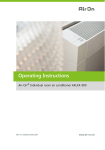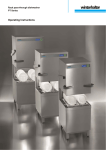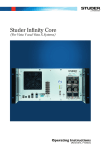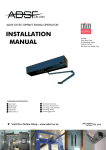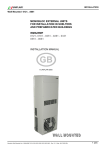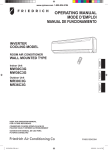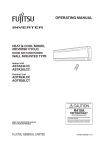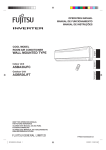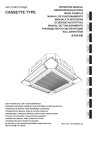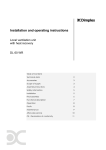Download Installation and Operating Instructions
Transcript
Installation and Operating Instructions Split Air Conditioner for Wall Mounting KSS 2508 AIV KSS 3508 AIV KSS 4508 AIV Technical data ............................................................................................................................. 2 Energy efficiency ......................................................................................................................... 3 Checklist ...................................................................................................................................... 4 Refrigeration plan ........................................................................................................................ 4 Safety regulations ........................................................................................................................ 5 Device construction ..................................................................................................................... 6 Installation instructions ................................................................................................................ 7 Scope of supply ........................................................................................................................... 7 Minimum clearances.................................................................................................................... 8 Assembling the indoor unit .......................................................................................................... 9 Assembling the outdoor unit ...................................................................................................... 10 Refrigerant pipes ....................................................................................................................... 11 Connecting the refrigerant pipes on the outdoor unit ................................................................. 12 Electrical Connection ................................................................................................................. 13 Start-up...................................................................................................................................... 13 Important notes on operation..................................................................................................... 14 Circuit diagram........................................................................................................................... 15 Operation................................................................................................................................... 18 Cleaning and maintenance ........................................................................................................ 21 Faults......................................................................................................................................... 22 Warranty, after-sales service ..................................................................................................... 23 1 Technical data Split room conditioners KSS 2508 AIV KSS 3508 AIV KSS 4508 AIV Indoor unit KSS 2508 AIV I KSS 3508 AIV I KSS 4508 AIV I Outdoor unit KSS 2508 AIV A KSS 3508 AIV A KSS 4508 AIV A kW 2.50 / 2.70 3.50 / 3.85 4.50 / 6.00 m³/h 450 550 800 Cooling capacity / heat output 1) Air volumes, indoor unit 1/N/PE ∼230 V Connection voltage Nominal power consumption for cooling / heating kW 0.73 / 0.85 1.16 / 1.27 1.58 / 2.05 Sound power level, outdoor / indoor unit (approx.) db(A) 53 / 40 55 / 42 56 / 45 Net weight outdoor / indoor unit kg 40 / 8.5 45 / 11 52 / 20 Dimensions, outdoor unit (W x H x D) mm 830 x 540 x 320 830 x 540 x 320 914 x 685 x 384 Dimensions, indoor unit (W x H x D) mm 770 x 250 x 180 830 x 285 x 189 1020 x 319 x 234 Condensate hose extension, indoor unit Required inner hose diameter mm 17 Height difference indoor unit - outdoor unitmaximum m 10 Length of refrigerant pipe, maximum m 20 Refrigerant R 410A Temperature range, cooling Indoor unit (adjustable range) Upper operating limit +33 °C / lower operating limit +18 °C Outdoor unit (fixed-setpoint conditions) Upper operating limit +43 °C / lower operating limit -10 °C Temperature range, heating Indoor unit (adjustable range) Upper operating limit +30 °C / lower operating limit +16 °C Outdoor unit (fixed-setpoint conditions) Length of plug cable, indoor unit Upper operating limit +43 °C / lower operating limit -15 °C m 1,5 Energy efficiency class cooling Energy efficiency value (cooling/heating) A B C 3.42 / 2.64 3.02 / 2.73 2.93 / 2.85 Special accessories refrigerant pipe consisting of an insulated suction and pressure pipe pre-filled with refrigerant and with coupling and electrical connecting cable. Pre-filled refrigerant pipes, length 2 m KMSL 1412-2 AIV Assembly accessories consisting of 2 brackets with dampeners for wall mounting of outdoor unit Wall bracket WKS 357 Condensate pump accessory consisting of float-type switch and separate pump Condensate pump KSI 3100 Refrigerant pipes may be joined to extend them. For refrigerant pipes longer than 8 metres, an on-site extension by the refrigeration technician is recommended. 2 Energy efficiency Energy Room air conditioner Manufacturer: Outdoor unit Indoor unit Dimplex Dimplex Dimplex KSS 2508 AIV A KSS 3508 AIV A KSS 4508 AIV A KSS 2508 AIV I KSS 3508 AIV I KSS 4508 AIV I Low energy consumption A B C High energy consumption Annual energy consumption kWh in cooling mode 365 579 780 2.50 3.42 3.50 3.02 4.50 2.93 - Yes Yes Yes - Yes Yes Yes kW 2.70 E 3.85 E 6.00 D (Actual consumption depends on usage of the device and cooling conditions) Cooling capacity Energy efficiency value kW At full load (the higher the better) Type Cooling function only Cooling function / heating function Air cooling Water cooling Heat output Energy efficiency class of heating function A: Low energy consumption G: High energy consumption Noise 3 Data for KSS 4508 AIV Standard EN 14511 Room air conditioner Energy Labelling Directive 2002/31/EC Data for KSS 3508 AIV The brochures include a data sheet with further information on the devices Data for KSS 2508 AIV dB(A) re 1 pW Checklist • Has a calculation of the cooling load been made? • Is the cooling capacity of the device sufficient for the room to be cooled? • Are the operating limits sufficient for the purpose for which the air conditioner is intended? • Are the walls or the foundation for the installation of the outdoor unit strong enough? • The indoor unit should be installed in a position where it ensures uniform cooling. • Minimum clearances must be observed. • Planning the installation of the outdoor unit: consider noise emission and free air circulation, avoid direct sunlight, ensure unimpeded access to the component, installation at locations without access by general public. • Is a wall bracket required for the outdoor unit? • Plan the power cable and connection; ensure adequate fuse protection. • Check the maximum length and feasibility of the refrigerant pipes. • Refrigerant pipes should be as straight and short as possible. • When routing the refrigerant pipes, it is essential to maintain a bend radius of 3.5 x pipe diameter. • Excess piping should be wound up at a downward angle to the outdoor unit in order to avoid displacement of refrigerant oil. • Take the height difference between indoor and outdoor unit into account. • If the outdoor unit is installed higher than the indoor unit: provide an oil siphon every 3 vertical meters. • Plan condensate drainage. If the condensate hose on the indoor unit cannot be routed with a downward slope, a condensate pump must be provided. The condensate is always formed at the “ cold” side of the air conditioner; this means for cooling in the inner component and for heating in the outdoor unit. • Is an approval by the local utility company required? Refrigeration plan Condenser Capillary Filter dryer Filter dryer 4-way valve Coupling Evaporator Compressor Damper Collector Coupling 4 Safety regulations General • Please read these installation and operating instructions carefully and fully before commencing installation! They contain important information about the assembly, use and maintenance as well as safety instructions to be observed! • After unpacking the device, inspect it for any transport damage. In case of doubt, do not put the device into use but have it examined by a qualified technician. • Before connecting the device, please ensure that the mains supply network corresponds to that required by the device according to the type plate data. Observe the utility company's local connection conditions. • The room air conditioner must not be operated in rooms where highly inflammable substances are used (e.g. solvents, etc.). • The device must be unplugged from the mains before any cleaning or maintenance work is carried out. • This device may be used only for the purpose for which it was manufactured, i.e. for heating, cooling, dehumidification and air recirculation of rooms. All other purposes are not those for which it was intended and must therefore be regarded as hazardous. • In the case of a fault and/or functional defect, please switch the device off (disconnect from the mains). Do not try to repair the device yourself. Necessary repairs must be carried out by the after-sales service. • The power supply cable may only be replaced by a qualified electrician. • The manufacturer is not liable for damage caused by improper or incorrect use or the incorrect installation of the device. Device-specific • The device must be installed according to the manufacturer’s specifications. Incorrect setup can cause injury to persons or animals and damage to property. • Where possible, the outdoor unit is to be installed in such a way that it is not exposed to direct sunlight. • The inlet and outlet vents of the air conditioner must not be covered or blocked. • Do not insert any objects into the device openings. • Disconnect the air conditioner from the power supply if the device is not operated for a longer period of time. • The air conditioner should be inspected at regular intervals (e.g. before the cooling season). • The condensate which collects in or runs out of the air conditioner should not be drunk. • Do not operate the room air conditioner without an air filter. • The air filters should be cleaned at regular intervals (depending on user and room). • Do not place any objects on top of the air conditioner. • The indoor unit of the air conditioner may be operated in dry rooms only. • Do not pour or spray any liquids onto or into the air conditioner. • Do not use hairsprays, solvents or similar materials (aerosols) in the vicinity of the air conditioner. • The air conditioner should be switched off immediately in the case of a fault (e.g. if smoke is created or an unusual smell is noticed). Disconnect the device from the power supply (switch off the fuse or pull out the plug) and contact an authorised after-sales service. • Keep persons with impaired health, small children and pets away from the direct air current since this may have a detrimental effect on their health. • The device may be assembled and disassembled only by a qualified technician. 5 Device construction 1 2 3 4 5 6 7 8 9 10 11 Indoor unit Air inlet Airflow fins (for adjustable air outlet direction) Air outlet Signal receiver (of the remote control) with indicator lamps Mains connection cable on indoor unit Outdoor unit Air inlet Air outlet Connection lines indoor unit - outdoor unit Condensate outflow hose 6 Installation instructions Before choosing an air conditioner, we recommend carrying out a cooling load calculation according to the standard, or on the basis of a relevant standard. Forms for cooling load calculation complete with instructions can be obtained from the manufacturer or wholesaler or on the Internet at www.dimplex.de Indoor or outdoor units, which are not installed according to instructions, may cause a reduction or loss of warranty in case of repair! Choosing the installation location It is very important to install split devices in suitable locations as it is difficult, and thus expensive, to move them after installation. If possible, decide on the installation location in agreement with the final customer. The installation site must be suitable for bearing the weight and the operational vibration of the indoor or outdoor unit on a permanent basis. Notes on the installation of the indoor unit The circulating air should flow through the whole of the room to be cooled. The flow of cold air should not be directed at persons or their place of work. The condensation formed during cooling must be drained off without impairing functioning. If the condensate can only be led off upwards or without a downward slope, then the installation of a condensate pump is necessary. The component may not be installed in rooms subject to high humidity in which the device is in contact with moisture or water. The device may not be installed in rooms in which oil vapour is emitted or could be emitted. Notes on the installation of the outdoor unit The outdoor unit should be installed in a place where it will not become soiled. When there is a danger of condensate freezing (heating operation when outside temperatures are low), the condensate drain stubs should be removed and additional insulation be provided for the drainage area. Freezing condensate (e.g. the formation of ice on the heat exchanger) can impede the fan function of the outdoor unit. The outdoor unit must be installed in compliance with the regulations regarding the assessment of operational noise in the neighbourhood. In particular, a suitable distance from bedrooms and similar rooms should be maintained. The device may not be installed in areas of aggressive air! Scope of supply Please check that the delivery is complete and that the devices are undamaged. The scope of supply includes: • Split air conditioner consisting of indoor and outdoor unit (2 packaging units in case of complete order), • Mounting plate for wall mounting of the indoor unit, slotted into it (incl. screws) • Remote control (incl. 2 batteries), • Condensate drain plug for draining condensate in the outdoor unit, • Control line with connection plug routed in the refrigerant pipe, • Mains connection cable, • Installation and operating instructions 7 Minimum clearances All dimensions in mm 8 Assembling the indoor unit Installation instructions Bends in the refrigerant pipes may not be positioned immediately before or after refrigerant couplings! If it does not matter whether the pipes are visible in the room, they can be led out of the side of the indoor unit to the left and routed through the wall at some other suitable location. Perforated sections are provided accordingly in the housing area of the indoor unit. Indoor unit Wall Downward slope Wall mounting Drilling through the wall One opening in the wall with a minimum diameter of 80 mm is necessary for the passage of the condensation hose as well as the refrigerant and electrical lines from the indoor unit to the outdoor unit. The opening must slope downward at an angle of about 5° toward the outside wall to allow the condensate to drain. Insert a bushing into the wall opening to prevent damage to the lines! The end of the condensate hose may not be stand in the water. min. 5° The diagram below shows the recommended position for the wall opening depending on the minimum distances. 150 Front view 150 150 B Ø=80 60 80 A 2000 KSS 2508 KSS 3508 KSS 4508 Maß A 770 830 1020 Maß B 250 285 310 Installation The mounting plate for the indoor unit must be aligned horizontally and mounted while observing the minimum clearances. Route the lines through the wall opening. Engage the indoor unit in the upper profiles of the mounting plate and swivel it downward until the indoor unit engages. 9 Assembling the outdoor unit Mount the outside component on a suitable support or wall with adequate load capacity. The wall bracket WKS 357 is available as an accessory. • The inflow and outflow of air must be unimpeded. • An air short circuit must be avoided. • Minimum clearances must be observed. • Distances to bedrooms and third-party rooms should be selected as large as possible to avoid annoying noise. See “ Technical Data” for sound power levels. Top view of outdoor unit E C D Distances between the drilling holes for mounting the outdoor unit. All dimensions in mm. Type Dim. A Dim. B Dim. C Dim. D Dim. E KSS 2508 AIV KSS 3508 AIV KSS 4508 AIV 288 288 342 320 320 384 540 540 550 760 760 844 70 70 70 Condensate drainage in the outdoor unit During heating operation there is a formation of condensate which must be drained. There is a hole (diam. 25) for condensate drainage in the base plate of the outdoor unit into which the condensate drainage plug supplied can be inserted. If the installation situation permits this, the condensate formed can drip down from the bottom side of the outdoor unit; otherwise drainage must be provided by connecting a hose. Caution! • If possible, the drain house should not be fixed. • If a condensate hose is is installed, it must always slope downwards. The condensate may possibly freeze when heating below temperatures of +4 °C. This may block the fan. If temperatures below +4°C are to be expected at the condensate outlet during heating operation, appropriate measures, e.g. insulation (insulation of the base of the casing and the condensate drainage area) should be taken. Sealing the wall opening This is not done until the outdoor unit has been installed and all necessary connections between the indoor and the outdoor unit have been made. The wall openings must be closed in a correct manner. In the case of fire protection walls, the relevant regulations must be complied with. 10 Refrigerant pipes Technical information The refrigerant pipes, the indoor and outdoor units are pre-filled with refrigerant R410A. The refrigerant R410A belongs to group 1 of refrigerants according to VBG 20. It is non-combustible and does not cause serious damage to human health. The following must be observed when installing refrigerant pipes: • • • • • • • The refrigerant should not come into contact with the eyes (if necessary, protective goggles should be worn). Refrigerants can cause frostbite in contact with the skin (if necessary, suitable protective clothing, such as gloves, should be worn). Contact with open flames or very hot surfaces can cause the refrigerant to decompose and give off poisonous gases. Caution! Do not smoke while disconnecting or closing refrigerant pipes! Do not inhale the refrigerant! Refrigerant is heavier than air; if it leaks it collects on the ground. In high concentrations it can cause a lack of oxygen. There is a danger of suffocation. A defective refrigerant pipe must be properly disposed of by a qualified specialist company or the authorised customer service. Installation If possible, the refrigerant pipes should be routed in suitable conduits (e.g. conduits for electrical installations) which allow the pipes to be replaced in case of replacement or repair. • Subsequently wrapping the refrigerant pipes with cloth adhesive tape protects the line insulation from damages due to UV rays and mechanical impact (rubbing against walls, bird bites). As an additional benefit, it makes the installed pipes more rigid - thereby reducing vibration. • The pipes may not have more than three bends in succession and not more than 12 bends over their entire length. • The number of bends should be kept to a minimum. • The radius of the bends must be at least 3.5 times the external diameter. • Install the pipes with a downward slope toward the outdoor unit or wind them up to prevent residues of refrigerant oil. If the height difference between indoor and outdoor unit is greater than 3 metres, a siphon-type bend must be created every 3 metres of height difference. For example, 2 bends at 6 metre height, 3 bends at 9 metre height, etc. Outdoor unit installed higher than the indoor unit Refrigerant flow Provide a siphon every 3 vertical meters. Oil separator 11 Connecting the refrigerant pipes on the outdoor unit Important information • Preventing dirt and moisture from entering the system is imperative; clean all connections with a dry cloth, if necessary. • The coupling connections may be loosened or opened again after connecting them, if required. Avoid frequent opening. • Repairs must only be carried out by an authorised after-sales service. 1 1 2 2 Remove dust caps/ transport protection. Pull back the locking ring. Push on the refrigerant pipe coupling. A 3 3 4 4 Push the locking ring forward again and close the fastening tab. Secure the connection with a screw (A) to prevent unintentional loosening. Insulate the refrigerant connections to prevent condensate formation. 12 Electrical Connection Electrical connection on the outdoor unit - Remove the cover, open the strain relief clamp, plug in the plug, fasten the grounding wire to the mounting plate, fasten the electrical cable to the strain relief clamp, attach the cover again. Electrical connection on the indoor unit The power supply of the indoor unit and the outdoor unit is done via the pre-installed connecting cable with power plug on the indoor unit. • • • • • Operation only with 230 V AC! Observe the safety and connecting conditions! Provide separate fuse protection for circuit! Connection and repair only by a qualified specialist! Provide a disconnecting device in the permanently installed wiring with at least 3 mm conctact opening at each pole (e.g. automatic circuit breaker) Electrical connection on the outdoor unit Start-up Check the following before start-up: • Are all refrigerant pipes and connections tight (e.g. using a leak test spray)? • Has the electrical installation been carried out correctly? • Have the indoor and outdoor units been installed in a secure and vibration-proof manner? • Have the refrigerant pipes been routed correctly? • Has the max. permitted length not been exceeded? • Have the coupling elements on the outdoor unit been insulated? • Have all installation residues or contamination been removed from the indoor and outdoor unit? • Have the air filter and condensate drainage pipes been installed properly? • Were functioning batteries correctly placed in the remote control? Function test • Plug in the device and turn on the circuit breaker. Operate the “ ON/OFF” button of the remote control. • Operate the “ MODE” button of the remote control. • Check all operating modes (cooling, circulation, heating, dehumidifying) if the ambient temperatures permit this (application limits). • Certain start-up times or pauses depend on the function when switching from one operating mode to another. If the device cannot be switched on using the remote control: − − Open the front of the indoor unit. Operate the AUTO/STOP button (at the right upper corner). Checking the function of the remote control must now be possible. 13 Information on the efficient use of the device Important notes on operation • • Use the air conditioner only for the following purposes: • for room cooling, • for room heating, • for room dehumidification, • to circulate the air in the room. • Keep windows and doors closed during air conditioning! Select the suitable setting of the airflow direction direct the airflow downward in heating operation, direct the airflow upward in cooling operation. In cooling operation, set the room temperature no more than 5° below the outside temperature. Heating operation The device operates with heat pump switching. Heat is extracted from the outside air, then led to the indoor unit and released in the room. The heat output diminishes as the temperature of the outside air drops! If the device does not provide sufficient heat for the room, we recommend operating it in combination with another heater. Heat pump air conditioners circulate the warm air in order to heat the entire room. It therefore takes some time until the entire room is warm (also depends on the external temperature and the heating requirement). Permissible temperature and humidity ranges Temperature range of outdoor unit* -10 °C to +43 °C Humidity range of outdoor unit approx. 40 to 80 % Cooling Temperature range of indoor unit* +18 °C to +33 °C Humidity range of outdoor unit approx. 40 to 80 % Automatic de-icing If the device is exposed to high humidity over a long period, condensate may form and drip down. When external temperatures are low and air humidity is high, heating operation can cause the formation of ice on the outdoor unit - which reduces the heat output. Temperature range of outdoor unit* -10 °C to +43 °C In this case, the device switches automatically to the “ De- Humidity range of outdoor unit approx. 40 to 80 % frost” mode for 10 – 15 minutes, heating is interrupted and the fans cease to operate. Heating Temperature too high If the device is exposed to high humidity over a long period, condensate may form and drip down. Temperature range of indoor unit* +18 °C to +33 °C When, in heating operation, both room and external temperatures are too high, the fan of the outdoor unit may switch off periodically (protective function). Humidity range of outdoor unit approx. 40 to 80 % Power disruption/ power cuts * If the device is exposed to higher temperatures, the automatic safety mechanism may be triggered and operation may be interrupted. If the device is exposed to lower temperatures, ice may form on the heat exchanger, which can cause water (condensate) to run out or lead to other malfunctions. After a power cut the devices restart operation in the operating mode last set (with the temperature setting last stored). This occurs in cooling and dehumidifying mode with a starting delay of approx. 3 min. In heating operation this restart phase can last up to 17 minutes. The alignment of the airflow fins (SWING) may need to be reset after a power disruption. 14 Circuit diagram KSS 2508 Indoor unit Outdoor unit 15 Circuit diagram KSS 3508 Indoor unit Outdoor unit 16 Circuit diagram KSS 4508 Indoor unit Outdoor unit 17 Operation Operating display on the remote control Function buttons of remote control 1 2 3 4 5 6 7 8 9 10 11 12 13 14 15 16 17 18 19 20 21 22 23 24 25 26 Remote control Display window Select operating mode Automatic / Cooling / Dehumidifying / Circulation / Heating Swing operation On/Off Setting the current time Setting the timer function - switch-off time Setting the time - increasing the time Deactivating the timer function Setting the time - reducing the time Timer function - setting the switch-on time Sleep function On/Off Fan level – Selecting the speed Increasing the default room temperature Decreasing the default room temperature Operation On/Off 27 28 29 30 31 18 Fan speed is determined automatically Fan on Fan speed low / normal / high Send - default is sent. Dehumidifying operating mode Heating operating mode Sleep function set Circulation operating mode Swing operation ON display Current time, set timer time AM – time before noon PM – time afternoon ON – time timer On OFF – time timer Off Timer function activated Room temperature default Automatic operating mode Cooling operating mode Inserting the batteries in the remote control Setting the fan speed Remove the cover of the battery compartment. The fan speed can be set at three levels. The fan speed is set with the FAN (12) button. Insert two “ 1.5 V MICRO AAA” batteries in the battery compartment. Observe the polarity (+/-) in the housing. Replace the cover of the battery compartment. The fan speed cannot be changed in the dehumidifying operating mode. Press the ON/OFF (15) button to switch on the device. Press the FAN (12) button once or several times until the desired fan speed (18) is set. Note: Insert new batteries if the display of the remote control is weak or flickers or cannot be seen at all. Cooling Press the ON/OFF (15) button to switch on the device. Press the MODE (3) button once or several times until the Cooling (31) display appears. The desired room temperature can be set with the TEMP+ (13) and TEMP- (14) buttons. Setting range: 16-30 °C, setting increments: 1 °C. Dehumidification Press the ON/OFF (15) button to switch on the device. Press the MODE (3) button once or several times until the Dehumidification (20) display appears. The desired room temperature can be set with the TEMP+ (13) and TEMP- (14) buttons. Setting range: 16-30 °C, setting increments: 1 °C. In the Dehumidification operating mode, the fan works only at a low speed to achieve optimal dehumidification. Circulation mode Press the ON/OFF (15) button to switch on the device. Press the MODE (3) button once or several times until the Circulation mode (23) display appears. The desired room temperature can be set with the TEMP+ (13) and TEMP- (14) buttons. Setting range: 16-30 °C, setting increments: 1 °C. Setting the time Press the CLOCK (5) button. The display (26) AM (before noon) or PM (afternoon) flashes. Set the current time with the TIME + (7) or TIME - (9) buttons. Briefly touching the buttons causes a change in 1-minute increments. Prolonged touch of the buttons causes a change in 10minute increments. Heating Press the ON/OFF (15) button to switch on the device. Press the MODE (3) button once or several times until the Heating (21) display appears. Press the CLOCK (5) button to store the set time. The desired room temperature can be set with the TEMP+ (13) and TEMP- (14) buttons. Setting range: 16-30 °C, setting increments: 1 °C. 19 Automatic mode Swing operation Depending on the room temperature, the operating modes COOLING and HEATING are determined automatically. The temperature cannot be set manually. Up – down air flow The Swing operation can be turned on and off using the SWING (4) button. Furthermore, the air flow can be specified for a specific air outlet direction. Press the ON/OFF (15) button to switch on the device. Press the MODE (3) button once or several times until the AUTO (30) display appears. Press the ON/OFF (15) button to switch on the device. Press the SWING (4) button. The SWING (24) display appears. The direction of the air flow is continuously changed from top to bottom and vice versa. The Swing operation is switched off again by pressing the SWING button once more. The operating mode COOLING is selected automatically: at temperatures of 25 °C or higher. The operating mode HEATING is selected automatically: at temperatures of 25 °C or lower. Timer function Left – right air flow The horizontal air outlet direction is set manually. The time-dependent operation of the air conditioner can be programmed on the remote control. Select the switch-on time Press the T-ON (10) button – the ON (27) display flashes. Set the current switch-on time with the TIME + (7) or TIME - (9) buttons. Press the T-ON (10) button once more to store the selected switch-on time. Select the switch-off time Press the T-OFF (6) button – the OFF (27) display flashes. Set the current switch-off time with the TIME + (7) or TIME - (9) buttons. Press the T-OFF (6) button once more to store the selected switch-off time. Adjusting the airflow fins NOTE: In the operating modes Cooling and Dehumidifying, condensate can form on the airflow fins turned to the right or left, and may possibly drip down. Use this setting, therefore, only for a short time. Delete timer settings Press the CANCEL (8) button. Special care must be taken when using the air conditioner in rooms with infants, small children, elderly or sick persons to prevent any danger to health. Sleep function To increase your comfort while sleeping at night. Reduces the fan speed and controls the specified room temperature values even more precisely. This function is only available in the operating modes Cooling (31), Dehumidifying (20) and Heating (21). Press the ON/OFF (15) button to switch on the device. Press the SLEEP (11) button - the Sleep function (22) display appears. 20 Cleaning and maintenance The device must be disconnected from the mains and allowed to cool down before cleaning and maintenance. Clean the surfaces of the casings with a soft damp cloth and then dry them. Use only lukewarm water. No scouring agents or polishes should be used. Auxiliary filter Remove the two auxiliary filters, if present, as well. Cleaning the air filters Soiled filters reduce the airflow and thus the efficiency of the device. Soiled filters can also cause noise. Both filters should be checked at the beginning of the active period and cleaned as necessary. The degree of soiling largely depends on the location and operating conditions. More frequent cleaning may be required. Take hold of the front cover of the indoor unit on both sides and flap it up until it clicks into an open position. Clean the air filter with a vacuum cleaner. If the filters are heavily soiled, they can also be cleaned with a neutral cleaning solution. The air filters must be completely dry before installing them again. Installation is done in the reverse order. Push the filter slightly upward at one side until it disengages from its locked position. Fully remove the filter. Repeat the procedure with the second filter. 21 Faults In case of malfunction, stop the operation of the air conditioner immediately, deactivate the unit and disconnect from the mains. Switch off the automatic circuit breaker in the manifold and pull of the mains plug, if necessary. Contact the after-sales service. You can detect possibly impaired function by a reduced output, smoke development, unusual odours, loud noises, increased tripping of the fuse or unusual heat development. However, before you contact the after-sales service, please use the list below to check whether this could be a normal occurrence or a fault you can remedy yourself. Type of fault Possible causes Device does not switch on immediately If the device is switched off and then on again immediately, a safety function prevents it operating for about 3 minutes (compressor safety function). The same thing happens when disconnecting the air conditioner from the mains and then switching it on again. Again the safety function prevents the operation of the device for approx. 3 minutes. A delay of up to 17 minutes can occur before the heating function starts or warm air begins to circulate, e.g. when the operating mode is changed or there is a power cut when in heating mode. Noises Noises caused by the flow of the refrigerant through the pipes can sometimes be heard during operation. These noises tend to occur particularly during the first two to three minutes after switching on or off. Temperature fluctuations cause material expansion and contraction, which can also produce noises. Smells The air emitted by the indoor unit may carry various smells already present in the room, e.g. cooking smells, tobacco, new furniture, etc.). Because the airconditioned air is emitted at a higher speed, the smells can be perceived as more intensive. Emission of steam or vapour Slight vapour formation may be visible at the device during cooling or dehumidification. This is due to the sudden cooling of the existing room air by the climatised air and is normally no longer perceivable after a few minutes. Device is not working Is it connected to the mains power supply? Has a fuse blown? Have the operating limits been exceeded? Has a power cut occurred? Are the batteries in the remote control working? The device switches off or on unintentionally The timer function may possibly be activated. The command entered on the remote control is not executed Depending on the operating mode selected, impractical functions cannot be executed. Inadequate cooling or heating Do the air filters need cleaning? Are the device’ s inlet and outlet vents covered or clogged with dirt? Have additional sources of heat been switched on? (during cooling mode) Are the room temperature settings appropriate? Are the windows and doors in the room to be cooled or heated open? Has the correct fan speed been set (air volume)? Are larger window surfaces present during cooling operation through which direct sunlight enters the room? You may need to close the curtains, lower the blinds, etc. 22 Warranty, after-sales service The following conditions, describing the requirements and scope of our warranty service, do not affect the warranty obligations of the sales person from the sales contract with the end customer. We offer a warranty for the devices according to the following conditions: Based on the following conditions, we remedy defects of the device free of charge which can be proven to be due to material and/or manufacturing defects if they are reported to us without delay upon being detected and within 24 months after delivery to the first end customer. This period is 12 months when the device is used commercially. If the defect appears within 6 months after delivery and a successful start-up (heat pumps for heating purposes and central room ventilation devices) by the authorised after-sales service for complete systems, a material or manufacturing defect can be expected. This device is only covered by this warranty if it was purchased by a company in one of the member states of the European Union, it is operated in Germany when the defect occurs and warranty service can also be rendered in Germany. The defects which we have recognised as being covered by warranty are remedied in that the defective parts are repaired free of charge at our discretion or replaced by flawless parts. Exceptional costs of defect remedy due to the type or location of the device's use or poor accessibility of the device are not covered by us. The end customer must ensure free access to the device. Dismantled parts which we take back become our property. The warranty time for rework and spare parts ends with the expiration of the original warranty period for the device. The warranty does not cover easily breakable parts which affect the value or operational use of the device only insignificantly. The original purchase receipt with purchase or delivery data must always be presented. The warranty becomes void if the end customer or a third party did not comply with the applicable VDE regulations, the stipulations of the local utility company or our installation and operating instructions as well as the information and integration diagrams included in the project planning documents or if the our accessories required for proper functioning were not used. The liability for the consequences of modifications and work activities performed improperly by the end customer or third party becomes void. The warranty covers the device and the parts purchased from the supplier. Parts and devices not purchased by the supplier and system defects due to parts not purchased from the supplier are not covered by warranty. If the defect cannot be remedied or the repair is denied by us or unreasonably delayed, the manufacturer will either deliver a replacement free of charge or reimburse the reduced value. In case of providing a replacement delivery, we reserve the right to apply a reasonable usage for the time of usage incurred so far. Extended or other claims, especially those for compensation of damages incurred outside of the device, are excluded unless liability is legally mandated. In case of liability according to article 478 of the German Civil Code (BGB), the liability of the supplier is limited to the lump-sum service fees constituting the maximum amount. An extension of the warranty to 36 months for heater heat pumps and central room ventilation devices from the date of start-up but no longer than 38 months after delivery ex factory is granted under the following conditions: The prerequisite for accepting the extended warranty is the chargeable start-up by the authorised after-sales service for complete systems with a start-up log within an operating time (compressor runtime) of less than 150 hours. Defects noted in the start-up log must be remedied immediately. This is the basis for the warranty. The start-up log shall be submitted to the address specified below within one month after the start-up; the extension of the warranty period will be confirmed by this same address. The start-up costs flat charge includes the actual start-up and the travel expenses. No liability is assumed for the proper planning, dimensioning and execution of the overall system. Remedying system defects and waiting times are extra services. The start-up costs flat charge for all heat pumps for heating purposes is currently € 340 net and € 400 net for central ventilation systems, for each device, and is charged to the ordering party by the authorised after-sales service for complete systems. Price adjustments are reserved. In case of a situation requiring service, the authorised after-sales service for complete systems on site is notified who will quickly remedy the problem. You can find out about the after-sales service for complete systems responsible for your area by contacting the central service hotline of Glen Dimplex Deutschland GmbH. Glen Dimplex Deutschland GmbH Dimplex Division After-sales service for complete systems Am Goldenen Feld 18 95326 Kulmbach, Germany E-mail address Internet: [email protected] www.dimplex.de Phone No. +49 (0) 9221 709 562 Fax No. +49 (0) 9221 709 565 [email protected] To process your order, we require the production number (E-Nr.) and the device’s production date (FD). This information can be found on the type plate in the framed field. 23 Note on disposal Do not dispose of the unit with general household waste. The device must be taken to a local waste disposal plant. Glen Dimplex Deutschland GmbH Am Goldenen Feld 18 D-95326 Kulmbach Telephone: +49 (0) 9221 709 562 Fax: +49 (0) 9221 709 565 E-mail: [email protected] 24 Subject to technical changes Internet: www.dimplex.de kss08-gb_ba.doc 08/08/A

























